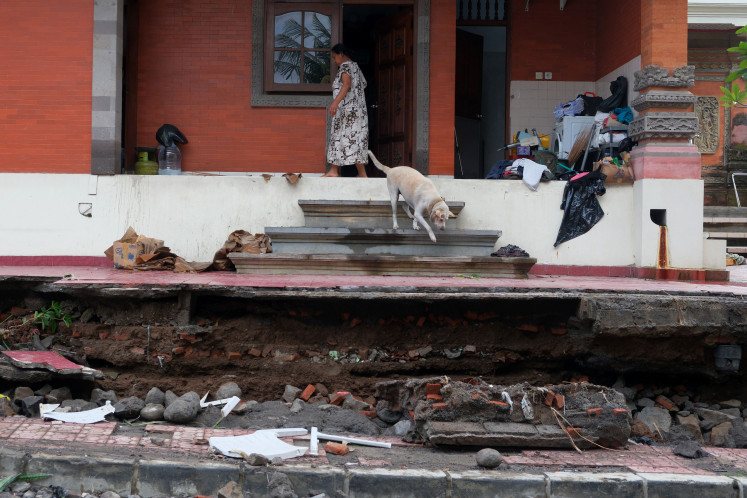Popular Reads
Top Results
Can't find what you're looking for?
View all search resultsPopular Reads
Top Results
Can't find what you're looking for?
View all search resultsThe style is not Father’s: Sudjojono’s son
S
Change text size
Gift Premium Articles
to Anyone
S
span class="caption" style="width: 468px;">S. Sudjojono: Visible Soul (Jakarta Museum S. Sudjojono, 2006) by Amir Sidharta. Puzzling: The above oil painting by S. Sudjojono, Kawan-kawan Repolusi (1947), experts and family members say, is similar to Wadjah-wadjah Pedjuang, a work thought to be by the same artist in the OHD Museum’s collection, which they say is “atypical” of the master’s work.Tedjabayu, the oldest son of Indonesia’s maestro painter S. Sudjojono, says he is not an art expert, and seeks answers to the case of three paintings claimed to be the work of his father in the Oei Hong Djien (OHD) Museum in Magelang, Central Java.
The paintings are Pangeran Diponegoro (Prince Diponegoro, 1960), Pekarangan Rumah (The Yard, 1950) and Wadjah-Wadjah Pedjuang (Fighters’ Faces, 1947). He raised his doubts about the paintings at the Fine Arts Round Table Discussion in Jakarta last week, which featured Oei Hong Djien as the main speaker.
Tedjabayu told The Jakarta Post that while the OHD Museum catalogue lists Wadjah-wadjah Pedjuang as a 1947 production, to his knowledge, during 1947-1950, his father only had two paintings left, titled Kawan-Kawan Revolusi (Friends of the Revolution) and Sajang, Kami Bukan Andjing (Unfortunately, We’re Not Dogs), while another estimated 45 works had been destroyed by the Dutch.
For three years, Sudjojono focused on supporting the independence movement, his son said, by drawing posters and other artwork. The maestro was always known as S. Sudjojono as he disliked his first name, Sindudarsono, Tedjabayu said.
Tedjabayu said Kawan-Kawan Revolusi was bought by Indonesia’s first president Sukarno, while Sajang, Kami Bukan Andjing is now in Surakarta, Central Java.
However he said he was surprised when he saw the Sudjojono painting titled Wadjah-Wadjah Pedjuang in the OHD Museum last April.
“The brush stroke is not Father’s style,” Tedjabayu told the Post, adding that he had also learnt sketching from his father.
A researcher on Sudjojono’s works, Amiruddin Siregar, separately said the painting style of Wadjah-Wadjah Pedjuang was not typical of the maestro, though at a glance it was similar to Kawan-Kawan Revolusi.
Other works by Sudjojono at the OHD Museum, he said, had “too many cream and yellow colors” compared to the typical light brown color that he noticed in other Sudjojono’s works.
“I don’t want to say they are fake”, said Amirrudin, but he said he could not explain the “difference in aesthetics”, among others, compared to what he knew of the maestro’s works.
On the work titled Pekarangan Rumah (The Yard, 1950) Tedjabayu said the yard looked different from the family yard in Yogyakarta, though the statue in the picture was similar. “Father always painted at home,” he said, “But I never saw him painting [Pekarangan Rumah]”.
Oei remarked that the maestro had likely painted another yard. “The title is not ‘Sudjojono’s House Yard’,” Oei told the discussion.
However he said the OHD Museum would initiate its own study regarding several of the questionable paintings in the collection.
“I would not damage my credibility by taking forged paintings into my museum. I am only a human being, and humans make mistakes,” Oei said.
Sudjojono’s paintings are among the main targets of forgery in Indonesian fine art. Besides being politically active, he was known as Indonesia’s pioneer in modernism, resisting what was considered the “colonial” influence in painting by Western artists.
Born in Kisaran, North Sumatra on Dec. 14, 1913, Sudjojono learned painting from a number of local painters, and from the Taman Siswa Teachers’ College in Yogyakarta, family members say.
In 1937, along with other maestros, Affandi and Hendra Gunawan, he set up the Association of Indonesian Drawing Artists (Persagi). Sudjojono represented the later-banned Indonesian Communist Party (PKI) in Indonesia’s first 1955 legislature.
In 1958 he quit the party and his legislative post, reportedly following his affair with his later second wife Rose Pandanwangi, which was considered against the party’s strict moral code.
Observers say his resignation from the PKI saved him from persecution under former president Soeharto’s rule — but for decades his son Tedjabayu, and first wife Mia Bustam, were political prisoners.
Tedjabayu was detained on Buru island in Maluku province, and his mother, a prominent figure in the PKI-associated Lekra (People’s Cultural Institute), was held in a number of women’s prisons in Java. She died in January last year.
Despite his nagging doubts, Tedjabayu, a staffer at the Jakarta-based Institute for Studies on the Free Flow of Information (ISAI), thanks Oei for preserving historic works of Indonesian art.
The maestro’s son said that when Sudjojono’s family attended the opening of the OHD museum, they were amazed and proud to see a painting portraying the family members.
“We appreciate OHD’s hard work. He is a national asset who has made a great contribution to Indonesian art,” Tedjabayu said.
Checking paintings: The basics
A forged painting, painters and experts say, is one that has similarities with the original, including the name or signature of the painter, the year of production and the title. Although forgery is hard to prove, the basic clues to investigate are as follows:
1. The style of the painter, including the use of color, the form of objects, harmony and lighting.
2. Genuinely old paintings have aged colors that strongly stick to the canvas, often with cracks, like a spider’s web
3. The canvas of a genuine painting should be qualitatively different from contemporary canvas.
4. Size of canvas, based on data on original work.
5. Signatures
6. Alteration of frames
Prospective buyers should buy only from respected institutions or galleries, and they can also check with the artists’ family members on the authenticity of the works.
From various sources










